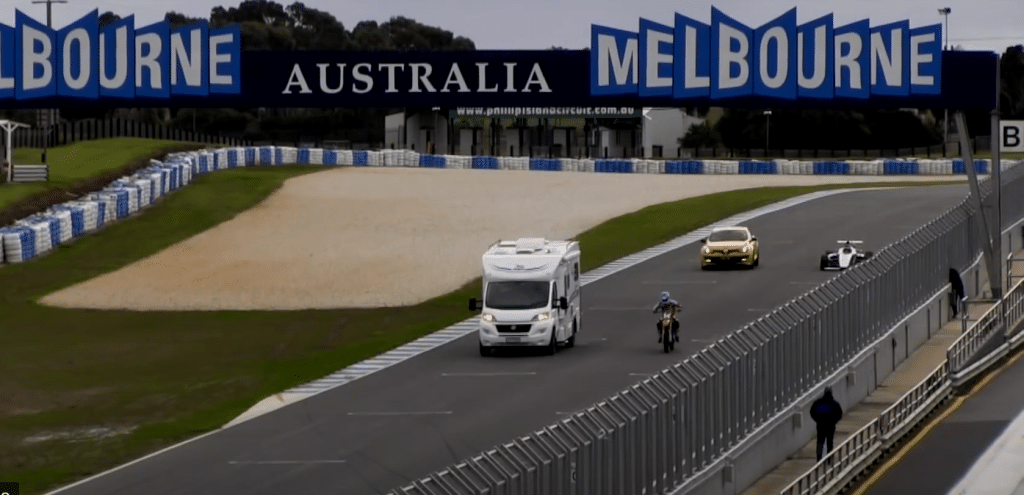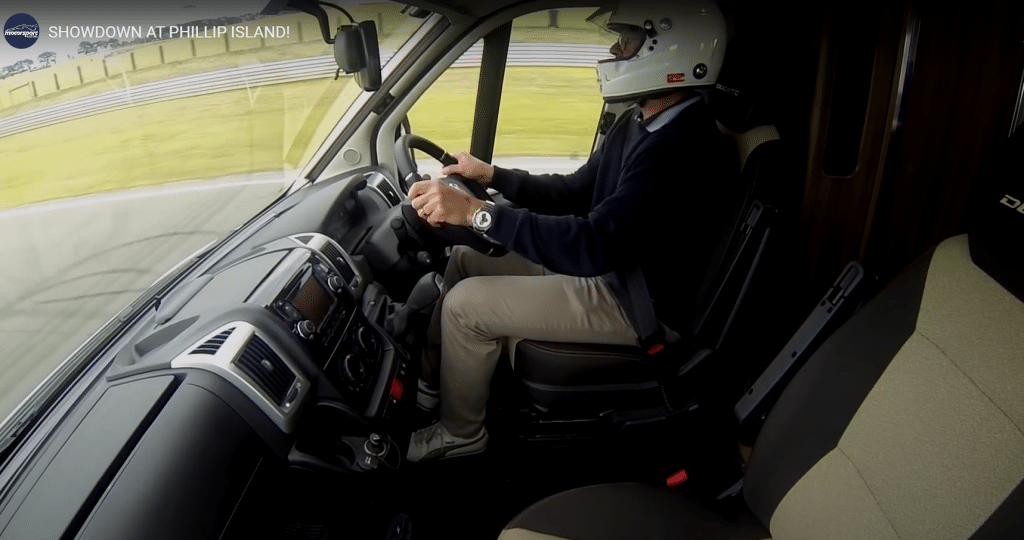What can caravanners and RV drivers learn from racing drivers?




Aside from having wheels and an engine, what does a racing car have in common with a caravan? What possible use would racing techniques be to the driver of a motorhome or tower of a caravan?
Well, you can think of racing as driving as fast as possible and you’d be pretty much right. And to drive as fast as possible you must utilise all the grip you have at your disposal, as well as convert as much energy as possible to forward momentum. It turns out that both of those techniques translate into RV driving, even if you don’t ever reach the vehicle limits.
But wait, you say, I don’t want to be squealing tyres or setting lap records with my Jayco! And fair enough. But wouldn’t you want to maximise your safety margins by driving well inside your grip limits, reduce fuel usage, and make quicker progress across country? That’s what I’m getting at here.

Now these techniques. The first one is the root cause of pretty much all novice racetrack errors and that is vision, or not looking ahead enough. I have seen many drivers simply drive their cars off a perfectly good racetrack and the reason why is they haven’t been looking far enough ahead. If they did, they’d see the trajectory their car is on and make a small correction early as opposed to large, energy-and-speed sapping correction late, or too late.
Exactly the same principle applies to RVs – whether they are a caravan or motorhome, you’re dealing with a lot of moving weight and you want to make tiny course corrections early, not jam on the brake at the last minute or steer late and harshly. So however far you’re looking ahead…look further, and the differences will become apparent. This is also the primary technique taught in advanced on-road driving.
After you’ve begun to look ahead, focus on minimising the amount of braking as you’ll need to accelerate to return to your cruising speed. For example, a couple of weeks back I was towing and following a Camry around a windy road. At every bend, the Camry would brake, often twice around the bend, and then accelerate out. I couldn’t hope to match the acceleration, yet I was easily keeping up by rolling off the throttle early, easing into the bend, maintaining momentum and smoothly applying power on exit. I’d end up close to the Camry on exit, only to have it power off into the distance. And I wasn’t anywhere near my maximum grip levels. I was also using something of a racing line; approach the corner from the outside, cut inside, exit outside.
Now the extent to which you can do this is quite limited on a public road and factors such as visibility take precedence, but even if you can move half a metre on way or the other on some bends makes a difference to the speed you can carry through the corner – or, keep the same speed and increase your safety factor and reduce tyre wear.

Then there’s grip management. This is more complex, and it starts with load transfer. This is sometimes erroneously known as weight shift, and it’s key to driving any vehicle efficiently and safely, be that a Formula 1 car or a B-double truck. Let’s say you’re entering a turn and you suddenly wrench the steering wheel into the turn. Your RV won’t want to turn, and when it does, it’ll roll one way or the other, using up most or all of its grip and therefore your safety margin. If on the other hand you turn in smoothly – slowly at first, then increasing the speed of steering of wheel rotation – then the load transfer will be more gradual and you will be cornering well within your grip levels.
A key to any form of vehicle control is the correct seating position and steering wheel grip, which applies to RVs as much as it does racing cars. For steering you want to be moving just your arms, not your upper body, and a grip of 9-3 across the wheel as shown below is ideal, although some larger steering wheels on trucks need more like a 10-2.
One stark difference between racing and road driving of this nature is braking. In racing, you want to brake as hard as possible, as late as possible. On road, it’s the complete opposite. Better to ease off the throttle and roll through a corner or set of lights than speed up to them and slam the brakes on at the last moment; the former approach is quicker overall, uses less fuel, and is easier on vehicle components especially brakes. And it’s safer. To start doing it all you need is that vision again, looking a long way forwards to predict traffic flow and road conditions.
Another difference between racing cars and RVs is responsiveness to power. In a race car, the response to throttle input is near instant. In an RV or diesel 4×4 towing, then there will be a noticeable delay between you foot moving down and the vehicle actually gaining momentum. So, you need to actually start your throttle inputs before you need them. Even 2-5km/h quicker out of a turn adds up and can well make a difference if there’s a hill ahead.
What you don’t want to be is that driver who exits the turn, and then, belatedly, decides to do something about accelerating. That lack-of-planning laziness works in a sports car, but you’ll pay for in in heavy vehicles; this is why truck drivers hate, really hate car drivers who rob them of their precious, hard-won momentum. There’s a saying in racing; slow in, fast out and that’s not a bad principle to work on with RVs either, smooth and cool in, early on the power for out for best progress.

Passing is another technique race drivers know a lot about, and I don’t mean divebombing under brakes. If you’re in equal cars, then you’ll need to plan your pass in advance, just like an RV driver. So when that rural road goes to dual lane you need to be already gathering speed and pulling out to overtake, not suddenly realising there’s a passing opportunity and then belatedly trying to accelerate because the lane will have closed down to one again well before your rig is ready to pass.
So there you go. I wonder what racing drivers could learn from RV drivers?